All of us want to keep our kids happy, healthy, and safe. For my family that means figuring out ways to spend as much time as possible outdoors.
Playgrounds, parks, trails, pools, we love it all. We especially enjoy getting together with friends and neighbors for cookouts capped of by a bon fire and s’mores!
Over the years I’ve often been asked how I keep my own children safe from mosquito bites.
I’ve finally decided to collect all of my tips in one place.
I have created this list from the perspective of easiest and most comfortable to more complex and requiring more planning ahead.
I suggest you think about your approach with what pest control professionals call – Integrated Pest Management. –
You are trying to prevent the mosquitoes from attacking your kids everyway you can. All of your tactics work together to lower their overall risk.
- Physical barriers
- Behavioral barriers
- Biological barriers
- Chemical barriers
Each of the suggestions I’ve included in this list can help reduce mosquito bites for kids.
The best effects will come when you do more than one of them, or ideally, all of them at once.

1. Stay Inside When Mosquitoes Are Active: Dawn, Dusk, & After a Rain Shower
This sounds like a no-brainer, but this simple tip is easy to forget.
Mosquitoes are most active at dawn, dusk, and after a rain shower.
For most of us thinking about a backyard barbeque, only the last two are relevant. (I decline most invitations to eat hotdogs at 5 am)
In the midsummer, dusk for most of the U.S. is around 8:15 – 8:30 pm. By that time the kids are often running wild and the adults are gathered around a patio table relaxing and chatting.
For many people, this twighlight time is their favorite time of the night.
It can be hard to break the party up and bring the kids inside. Especially when they are all hot and sweaty from running around. If you do that, the party is basically over.
This leads us to my next suggestion.
2. FANS – Bring Out The FANS!
Yes – FANS – I know, you probably think I’m crazy, but hear me out.
Fans are a 2 for 1 bargain:
Why?
1- Mosquitoes are weak flyers and are always looking for the path of least resistance to conserve energy. Because of this, even a light fan can work wonders.
What if for the barbeque, instead of asking people to bring an extra dish of potato salad, you ask people to bring a fan to contribute to the mosquito-fighting effort.
2- THEN as a bonus, all those fans feel really nice on a hot sticky summer night.
WARNING:
Everyone who is currently parenting a toddler has already spotted a glaring issue with the “Fan” proposal. Toddlers love to stick their fingers into the tiny grates of a fan. If you have curious toddlers at your party, stick to fans that the little humans can not reach.
But for any event where all the children will be old enough to not touch the fan, go for it. This is a low cost, physical/behavioral strategy to keep mosquitoes from biting your kids.
3. Stop Using Scented Lotions, Soaps, Wipes, etc
You know, mosquitoes do not see very well, in the terms that humans think about “seeing”.
You know what mosquitoes do very well?
Smell
Smell and heat are everything for them.
Guess where mosquitoes get their energy?
Blood you say?
Wrong.
Nectar. Fruit Juice. Honeydew. and other delicious sugary plant juices.
So, if you slather your child in lotion that smells like roses. Or you douse their hair in gel that gives them an awesome mohawk, but it smells like flowers.
Once your child is running and playing and getting hot and sweaty, that activates all of the feeding triggers for female mosquitoes. (They love the smell of lactic acid found in human sweat.)
To help keep your child free from mosquito bites, skip the smell-good things. Try to choose “basics” or “hypoallergenic” soaps or hair products. This also includes for detergents and dryer sheets, avoid any product that smells.
4. Keep Your Yard Clear of As Many Mosquito Breeding Areas as Possible
Mosquitoes lay their eggs in or near water, and they must be wet to become active and hatch. Then a few days later little wriggling larvae are born. They live in water the first few days of their life.
Then they become a little pupa which looks like a tiny question mark hanging in the water. In this stage, it does not feed, it does not move, it only respires and appears motionless. But, just like a butterfly in a chrysalis, a remarkable change is occurring inside the pupa.
A few days later, the adult emerges from its pupa case. For a few moments after emerging, it sits, motionless at the top of the water. Then if flys away to look for something sugary to eat.
It has been a long time since it last fed as a larva, and it needs the energy that sugars will provide.
Half are males, and do not bite hosts looking for blood. The other half are females and need bloodmeals to get the protein required to form their eggs; so they can start the cycle all over again.
Mosquitoes are weak flyers (see above section about FANS!)
Since they are weak flyers, they will stay as close as possible to the spot where they hatched emerged from the pupa form and took to the sky.
To keep mosquitoes out of your yard, keep it clear from debris that collects small amounts of water. Potential breeding sites include: FLEXIBLE DOWNSPOUT EXTENDERS, jars, broken wheelbarrows, empty flower pots, old junk cars, old junk lawn mowers, dilapidated lawn equipment, broken refrigerators, buckets, grill covers, yard decorations, kids toys, etc.
In my years in mosquito control I have seen mosquitoes breeding in just about everything you can imagine. Keep in mind they only need a thimbleful of water for a larva to mature into a pupae then an adult.
To keep your kids and any visiting kids free from mosquito bites – keep your yard clear of places where they can hatch, mature, and emerge.
When there is standing water you cannot remove consider using a BTI based larvicide. These work well, but they do not last long. If you needs something that lasts longer, consider using the tiny Spinosad tablets which last for 60 days and have a slow release mechanism built into the tablet.
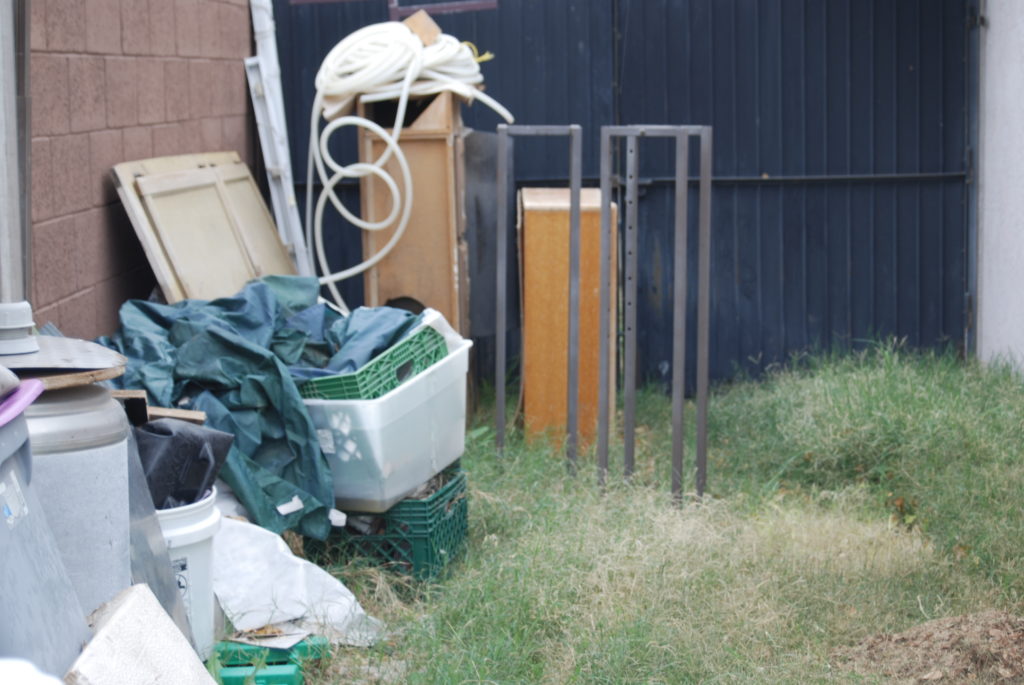
5. Stay Away From Popular Mosquito Hangouts
This one is sort of the flip side of #4. When your kids are at your house, and it is dusk, and you have your fans going. You have thought ahead and taken some steps to mitigate the mosquito-apocalypse.
But, your kids will not always be at your house.
Sometimes they will be at houses where the person is a collector of five gallon buckets, or where the fence is made of old tires and each tire has 500 Aedes albopictus larva wriggling around.
In those instances we have to tell our kids, “stay away from the part of the yard with the bucket collection”.
Mosquitoes do not like to travel far for their meals. If you kid can keep a few other kids between themselves and the mosquito breeding ground, they will be less likely to get eaten alive.
Then you the parent can have a word with the homeowner and talk to them about #4 on this list. (Or possibly only number 9 & 10 will be possible)
6. Protect Carriers and Strollers with a Mosquito Nets
If you are reading this in the U.S., you may think I’m crazy.
That is fine, I have been accused of that many times before.
But realize that in many parts of the world people sleep every night of their lives under a mosquito net.
It is a blessing to have these nets to help keep you and your children safe from the scourge of malaria, dengue, chikungunya, Onchocerciasis, or many other diseases.
And I assume that you would only consider this under extreme circumstances, say visiting Northern Minnesota during the last week of July. Or going camping in New Jersey in June. Or visiting the a State Park in Florida from March – September.
In those circumstances, you do not have many things you can control to keep the mosquitoes away. You can’t get rid of the standing water in the Minnesota boundary waters, there are millions of stagnant pools breeding mosquitoes. So you have to focus on keeping your child safe from bites by focusing protection closer to the child.
Picture your three month old baby napping peacefully near your campsite in the forest of Georgia. As your baby sleeps her breathing is forming a tiny invisible plume of carbon dioxide, and her body heat is sending up a little heat signal. Since she is not moving, she is easy prey. Soon the female mosquitoes will be on her. Biting her little defenseless arms and legs as she sleeps.
Now imagine that same scenario with just a simple mosquito net draped over the baby carrier and held up by the handle of the carrier. The net does not touch the baby, the air is till able to circulate freely, and yet there is a physical barrier between her and the mosquitoes. In fact, soon you will see the mosquitoes begin to land on the net and even stick their proboscis through the holes in the net, trying to get at your child. NOT TODAY!
Even though a mosquito net seems extreme, they really do work when used properly. And when you think critically, is this even the most extreme thing you have done for the safety of your child?
7. Clothe the Baby From Head to Toe
Yes, I’m including this further down the list because the summer is hot.
And me, personally, my kids were all heavy perspires, even when they were babies. I just remember picking up their tiny little bodies from a nap in their carrier and their little heads would be wet with sweat.
So the idea of covering your tiny human from head to toe is a little tough to imagine. BUT – we are talking about breathable loose fitting clothing. (Which has been washed in hypoallergenic, non flowery smelling detergent. It should just smell like nothing, like “clean”. That’s it – per suggestion #3 on this list.)
Note from the above video of mosquitoes proboscises piecing through netting trying to reach human skin, mosquitoes can bite through clothing. I’m sure anyone who is reading this article already knew that from first-hand experience.
But, also, mosquitoes are lazy, and it takes more energy to bite through cloth than to bite exposed skin, so think of this as just another possible precaution you can take to help protect your little one from bites.
8. Use Baby-Safe Mosquito Repellents
This is a huge one. Some of you are thinking – “This should have been #1 on the list!”
Please- talk to your pediatrician about this subject. Please. Don’t just trust “what you read on the internet”. Talk to a doctor who knows your child, you, your community, etc.
Here is the thing: MOSQUITO REPELLENTS SHOULD NOT BE APPLIED TO CHILDREN UNDER TWO MONTHS OF AGE.
So, for our tiniest little babies, we have to use all of the other tactics I’m describing here. – Clothing, nets, fans, not going outside during the mosquito feeding times.
Do not use products that combine mosquito repellent and sun screen. Sun screen should be reapplied much more frequently than the insect repellent. The sun is an unrelenting foe in the summer, while mosquitoes will come and go, the sun will keep shining and blasting your kids with skin baking UV rays.
Also, never put mosquito repellent on your child’s hands. Kids but their hands in their mouths. All the risk models about product safety change when we talk about the kid directly ingesting the repellent products. – You should apply the product to your own hands, then you rub it on your child. (Then of course you go and wash your hands immediately afterwards).
Tips to Remember:
Do This:
- Talk to your pediatrician about which products to use.
- Apply bug spray to your own hands, then rub onto your child's exposed skin.
- When using spray on bug spray, apply the product outdoors, before your kid is wearing the clothes.
- Use only as much bug spray as you need.
- When your filthy, sweaty kid is finished playing outside, make them take a bath or shower and use soap to remove the repellent from their skin.
- Immediately put clothes with repellent into the wash.
- For babies under two months use strategies like mosquito nets to protect them.
Avoid This:
- Don't just believe random advice on the internet. Consult your child's doctor about which repellent products to use.
- Don't use repellents for children under two months old. Instead use mosquito nets and light clothing that covers their whole body.
- Don't put bug spray on your child's hands.
- Don't apply a repellent product to any open cut or scratch on your child's skin - IT BURNS!
- Don't try to home make a concoction with instructions from the internet. The results might seem "more safe" but in fact could be both less safe and unlikely to prevent mosquito bites.
Children Older Than Three
For children older than three – yes, in many ways the easiest, and most reliable way to protect your kids from mosquito bites is to use, EPA approved, kid-safe mosquito repellents. And use them in the way that is explained on the label.
For me the controversy comes in the discussion between the EPA-approved repellents & the THOUSANDS of over-the-counter non-regulated products which profess to work, but are not officially endorsed by the U.S. Federal Government.
I’m sure you all know the products I’m talking about.
If you have young kids your social media feeds are filled with advertisements for these products all summer. They all promise the world. The part that concerns me is that I am slathering this stuff directly onto my child.
How I Use Mosquito Repellents with My Own Three Children
We use the double-threat approach.
Including 1 product we apply to the child and a second different product we spray on the clothes.
I have NO scientific method to support this approach.
The product we apply directly to our children is: Avon Skin-So-Soft Bug Guard with IR3535. We apply this to our own hands then rub it onto the exposed skin of our children.
The product we spray on the outside of their clothes (including hats) – is a 10% DEET aerosol spray. (We always apply this outdoors)
9. Hire Professionals to Treat Your Yard with Natural Mosquito Repellent Throughout Mosquito Season
Yes, I know, this one seems self-serving.
But the data is clear that professional barrier mosquito treatments, when applied correctly work very well to reduce the number of mosquitoes in a backyard.
Also, this is a list of “SIMPLE” things you can do to protect your kids & babies from mosquito bites. Choosing an excellent company to provide this service is very easy and convenient. If you would like to find someone who will apply Stop The Bites!, please contact us here, and we will help make a connection.
Here is one of the graphs published in the research which we also republished in our blog post:
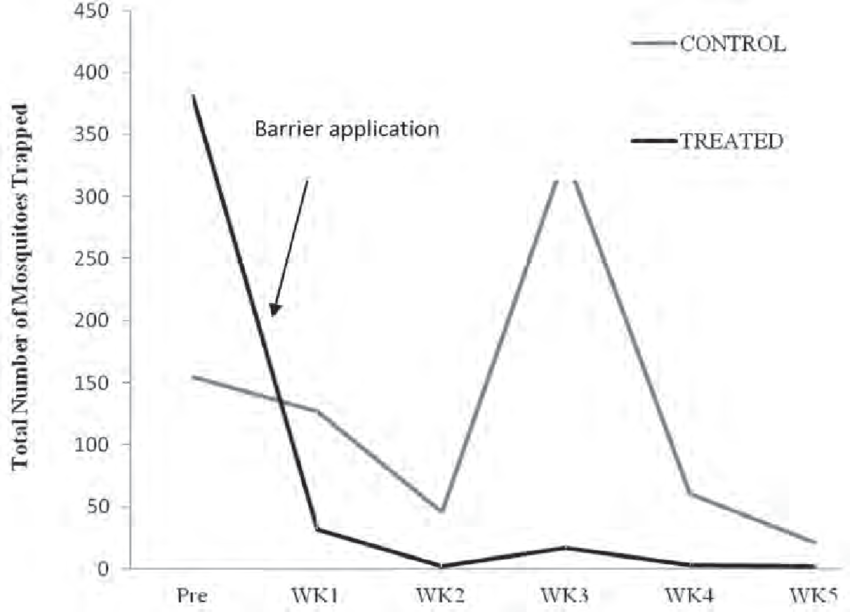
See the line crashing towards zero in the graph above? Then it stays down at a very low level throughout the timeline of the research.
As compared with the other line witch is very high?
Barrier treatments work very, very well when performed correctly.
What Do We Mean by, "Performed correctly"?
Mosquito control professionals have airblast backpack mister/ blowers. These machines send out a powerful blast of air (think of a turbo charged leaf blower) stirs up the foliage, at the same time depositing tiny particles of the professional mosquito control product.
This combination of stirring up the habitat and depositing the product in the exactly correct spot is key.
The product must come in contact with the mosquitoes when they are resting. These mosquitoes rest in the daytime in the middle of dark, dense foliage (among other places). Mosquito professionals have classes and training to understand mosquito biology and know exactly where they need to apply the product to achieve maximum impact on the population of mosquitoes in your yard.
Why Do We Need Multiple Applications Throughout The Season?
The first application will likely result in the largest reduction in number of mosquitoes.
However, many mosquitoes have a life-cycle of less than two weeks. And population growth is geometric, meaning it grows exponentially.
Since the best Natural mosquito repellent lasts three weeks, skipping a month of treatment can have a big impact. The result is not -double – the mosquitoes, but 4X, 8X, or 16X the number of biting female mosquitoes. (The calculation depends on the type of mosquito and the heat of the summer).
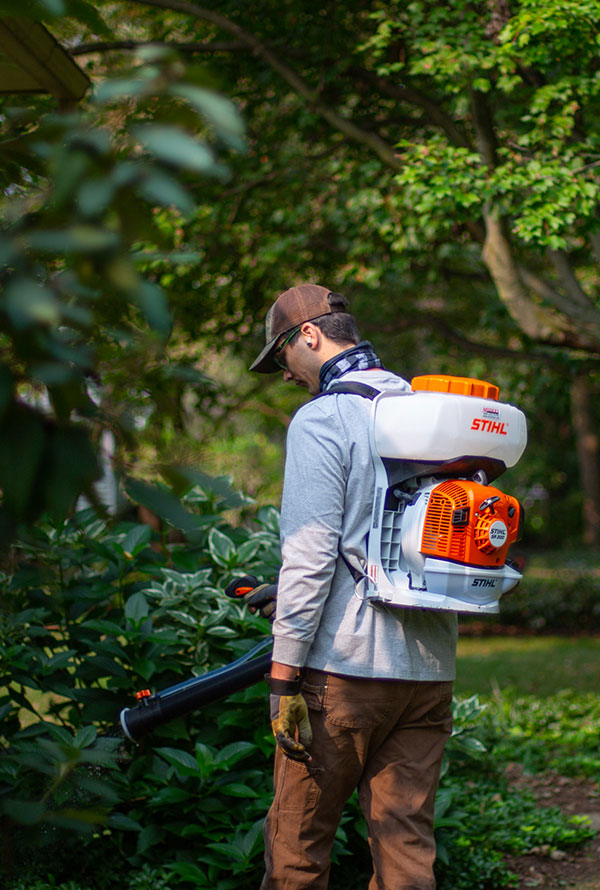
Should I Be Concerned to Have a Professional Treat My Yard With a Natural Mosquito Repellent?
No, you shouldn’t be concerned. The pest control professional you hire will know where to apply the product.
The places targeted for treatment will be places your child is less likely to access: eaves around the house, dense foliage, tree holes, underside of leaves.
Waiting until the spray has dried before re-entering the yard is an additional precaution you should take, just to be extra safe.
In addition, by using a professional Natural mosquito repellent you are taking an additional level of precaution.
10. Position Mosquito Traps Around Your Yard in Advance
The two main types of traps that work are –
- Gravid traps that target females looking to oviposit their eggs
- Light traps which use light and CO2 to attract mosquitoes
1. Biogents (distributed by BioQuip in the U.S.) is a reliable supplier of traps targeting gravid females. These little traps work very well. They use the smell of hay and organic matter getting ripe in the water in the bottom of the trap to signal to females that this is a great place for them to ovipost (lay) their eggs.
Once the female flies inside, she is unable to escape the trap after she lays her eggs.
Over a period of weeks, these traps can really help to reduce the mosquito population in a backyard.
2. My favorite brand of light traps is Dynatrap. But there are other brands available too.
I like that the Dynatrap products because they use both CO2 and light to attract mosquitoes. Then once the mosquitoes are physically trapped inside, they die there. They cannot escape. Then you just need to empty the carcasses of the dead insects into the trash.
One negative aspect of the light traps is that they will attract a lot of other insects that do no harm.
I love good insects, so finding them dead in the trap makes me kind of sad.
You will find a lot of flies, moths, beetles, spiders and other things in your traps in addition to your mosquitoes. Having spiders around actually HELPS your mosquito fighting efforts.
But, since this list is about keeping it simple, these traps certainly do that. And they also really work.
Warning Some Popular Types of Mosquito Traps Do Not Work
We recently published a blog about traps which claim to use yeast and salt water to kill mosquitoes.
There is not independent evidence that these work. Lots of information on this topic by Colin Purrington.
10b.(BONUS TIP) - Indoor Trap Advice: If Mosquitoes Are Biting Your Kids Inside Your House - Do This -
Mosquitoes do not respect boundaries.
If one (or more) of these rascals has made her way inside your house and is biting your children while they sleep.
Use her need for sugar rich foods against her with this DIY indoor mosquito trap.
This works for both male and female mosquitoes, but if you have only males in your house, you are unlikely to notice them.
https://colinpurrington.com/2020/06/diy-soda-bottle-mosquito-trap/
11. Call Your Local Public Health Mosquito Agency
This strategy is further down on our list because many people reading this article live in a place without publicly funded vector control.
Many rural areas and smaller towns do not have the resources required to treat for mosquitoes.
However, for those of you who DO live in a place with publicly funded mosquito control, you are in luck!
This team of dedicated, amazing professionals knows virtually everything about the mosquitoes in your area. AND they are happy to help you however they can.
We wrote a blog post about how awesome public service vector control is, here is the link.
This team can help you a lot because sometimes the mosquitoes that bite you in your yard travel many miles to come in and feed.
After they bite you, they return many miles back to their resting areas.
For these types of mosquitoes, treating in your yard will have little or no impact.
When you are in contact with your local mosquito agency and you alert them to your mosquito issue, you are providing them data. They then use this data to track where mosquitoes are active across your area.
Once they have enough reports about mosquito “hot spots” that will often influence when and how they treat for mosquitoes.
Conclusion
Here is the full list we talked about – for SIMPLE ways to protect your kids from mosquito bites:
- Stay Inside When Mosquitoes Are Active: Dawn, Dusk, & After a Rain Shower
- FANS – Bring out the FANS!
- Stop Using Scented Lotions, Soaps, Wipes, etc
- Keep Your Yard Clear of As Many Mosquito Breeding Areas as Possible
- Stay Away From Popular Mosquito Hangouts
- Protect Carriers and Strollers with a Mosquito Nets
- Clothe Your Baby From Head to Toe
- Use Baby-Safe Mosquito Repellents
- Hire Professionals to Treat Your Yard with Natural Mosquito Repellent Throughout Mosquito Season
- Position Mosquito Traps Around Your Yard in Advance
- Call Your Local Public Health Mosquito Agency
Each of these strategies can help a little, when you deploy them all together you are doing about everything you can to help protect your child from mosquito bites.


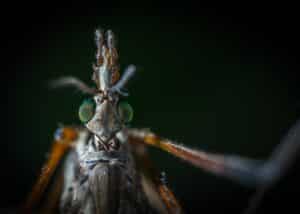

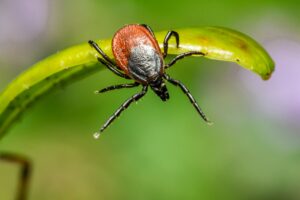
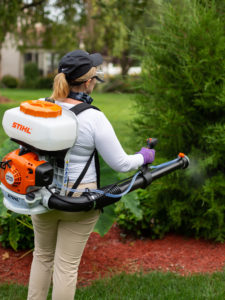

2 thoughts on “11 Easy Ways to Protect Kids from Mosquito Bites”
I was skeptical when I bought a Dynatrap. But now I wouldn’t trade it for anything.
That is so neat! Do you use them as part of the service you offer, or only for your own property? Which model do you recommend?